Study and Analysis of the Effect of Polyamide Seamless Knitted Fabric with Different Graphene Content on the Blood-Flow Velocity of Human-Skin Microcirculation
Abstract
1. Introduction
2. Materials and Methods
2.1. Materials
2.1.1. Selection of Yarn Scheme
2.1.2. Fabric Structure Design
- Weft Plain Stitch.
- 2.
- Rib Stitch.
- 3.
- Simulated Rib Stitch.
2.1.3. Establishment of Sample Scheme
2.2. Methods
2.2.1. Experimental Equipment and Test Principle
- Working Principle of the Instrument.
2.2.2. Experimental Materials and Test Methods
- Sample Specifications of Wrapping Arm.
- 2.
- Pre-Test Preparation Requirements.
- 3.
- Conditions of the Subjects and Test Sites.
- 4.
- Test Steps for Blood-Flow Promotion Multiples of Microcirculation on Human-Surface Skin.
- 5.
- Fabrics Test Scheme.
- 6.
- Calculation of Blood-Flow Promotion Multiple of Human-Surface-Skin Microcirculation.
3. Results
4. Discussion
- Through testing the promotion times of 12 samples woven by different types of veils and different tissue structures according to the comprehensive experimental design method on the blood flow of human-skin microcirculation, the results show that the order of the promotion effect of each sample on the blood flow of human-skin microcirculation was: 11# > 10# > 12# > 8# > 9# > 7# > 5# > 6# > 4# > 1# > 3# > 2#. The effect of 11# sample on the blood flow of human-skin microcirculation and its promotion ability was the best;
- In the test of promoting multiple blood flow on human-skin microcirculation, the type of veil had a significant effect on the observed variables, while the tissue structure had no significant difference. The higher the content of graphene in the veil yarn, the better the promotion effect of the fabric on the blood flow of the human-skin microcirculation. The fabric made of the veil type GP-0.8% had the best promotion effect on the blood flow of the human-skin microcirculation. The order of the promotion effect of the veil type on the blood flow of the human-skin microcirculation was: GP-0.8% > GP-0.2% > GP-0.1% > GP-0.0%. When the tissue structure was 1+1 simulated rib, the promotion multiple of the fabric on the blood flow of the human-surface-skin microcirculation was large. The order of the promotion effect of the tissue structure on the blood flow of the skin microcirculation was 1+1 simulated rib > weft plain stitch > 1+3 simulated rib.
Author Contributions
Funding
Institutional Review Board Statement
Informed Consent Statement
Data Availability Statement
Conflicts of Interest
References
- Robinson, C.; Seah, K.M.; Chee, Y.; Hindle, P.; Murray, I. Frozen shoulder. J. Bone Jt. Surg. Br. Vol. 2012, 94, 1–9. [Google Scholar] [CrossRef] [PubMed]
- Zhao, Z.J. Treatment of 96 cases of scapulohumeral periarthritis with far-infrared guided Chinese medicine therapy. J. Pract. Tradit. Chin. Intern. Med. 2007, 21, 93. [Google Scholar]
- Wang, Z.Z.; Wang, Y.P.; Wan, J.P. 67 cases of periarthritis of the shoulder treated by acupuncture combined with far infrared irradiation. Clin. J. Med. Off. 2010, 38, 533+542. [Google Scholar]
- Vatansever, F.; Hamblin, M.R. Far infrared radiation (FIR): Its biological effects and medical applications. Photonics Lasers Med. 2012, 1, 255–266. [Google Scholar] [CrossRef] [PubMed]
- Zihan, Z. Graphene modified fiber: Enjoying innovative application in all walks of life. China Text. 2019, 1, 48–50. [Google Scholar]
- Inoue, S.; Kabaya, M. Biological activities caused by far-infrared radiation. Int. J. Biometeorol. 1989, 33, 145–150. [Google Scholar] [CrossRef] [PubMed]
- Yu, S.Y.; Chiu, J.H.; Yang, S.D.; Hsu, Y.C.; Lui, W.Y.; Wu, C.W. Biological effect of far-infrared therapy on increasing skin microcirculation in rats. Photodermatol. Photoimmunol. Photomed. 2006, 22, 78–86. [Google Scholar] [CrossRef] [PubMed]
- Cracowski, J.-L.; Minson, C.T.; Salvat-Melis, M.; Halliwill, J.R. Methodological issues in the assessment of skin microvascular endothelial function in humans. Trends Pharmacol. Sci. 2006, 27, 503–508. [Google Scholar] [CrossRef] [PubMed]
- Spronk, P.E.; Zandstra, D.F.; Ince, C. Bench-to-bedside review: Sepsis is a disease of the microcirculation. Crit. Care 2004, 8, 462. [Google Scholar] [CrossRef] [PubMed][Green Version]
- Hai-yan, W. Reconstruction and application about weft plain stitch in the knitting sweater design. Wool Text. J. 2015, 43, 21–27. [Google Scholar]
- Rezaei, J.; Nikfarjam, A. Rib stitch knitted extremely stretchable and washable textile triboelectric nanogenerator. Adv. Mater. Technol. 2021, 6, 2000983. [Google Scholar] [CrossRef]
- Briers, J.D. Laser speckle contrast imaging for measuring blood flow. Opt. Appl. 2007, 37, 139–152. [Google Scholar]
- Heeman, W.; Steenbergen, W.; van Dam, G.M.; Boerma, E.C. Clinical applications of laser speckle contrast imaging: A review. J. Biomed. Opt. 2019, 24, 080901. [Google Scholar] [CrossRef] [PubMed]
- GB/T 6529-2008; Textiles—Standard Atmospheres for Conditioning and Testing. Standardization Administration of the People’s Republic of China: Beijing, China, 2008; p. 12.
- Gwosdow, A.; Berglund, L. Clothing distribution influences thermal responses of men in cool environments. J. Therm. Biol. 1987, 12, 91–95. [Google Scholar] [CrossRef]
- Palva, T.; Ramsay, H.; Northrop, C. Color Atlas of the Anatomy and Pathology of the Epitympanum; Karger Medical and Scientific Publishers: Basel, Switzerland, 2001. [Google Scholar]
- Jian, M.Q.; Zhang, Y.Y.; Liu, Z.F. Graphene Fibers: Preparation, Properties, and Applications. Acta Phys.-Chim. Sin. 2022, 38, 22–39. [Google Scholar] [CrossRef]
- Zhang, K.Q.; Du, D.Z. Functional fibers based on graphene. J. Text. Res. 2016, 37, 153–157. [Google Scholar] [CrossRef]
- Qi, D.Y.; Wang, X.Q.; Yuan, B.L.; Ni, B.X.; Zhu, R.D.; Lu, S.X. A Test Method Research for Textile Far-infrared Performance. China Fiber Insp. 2016, 6, 90–93. [Google Scholar] [CrossRef]
- Li, Y.; Wang, H.; Yao, X.J. Research Advance of Microcirculation Detection Method and Its Application in Disease. J. Chongqing Univ. Technol. (Nat. Sci.) 2014, 28, 52–56. [Google Scholar]
- Li, W.S.; Fang, L.L.; Sun, J. The Present Situation and Development Trend of the Detection of Functional Textiles. Adv. Text. Technol. 2016, 24, 56–58+64. [Google Scholar] [CrossRef]

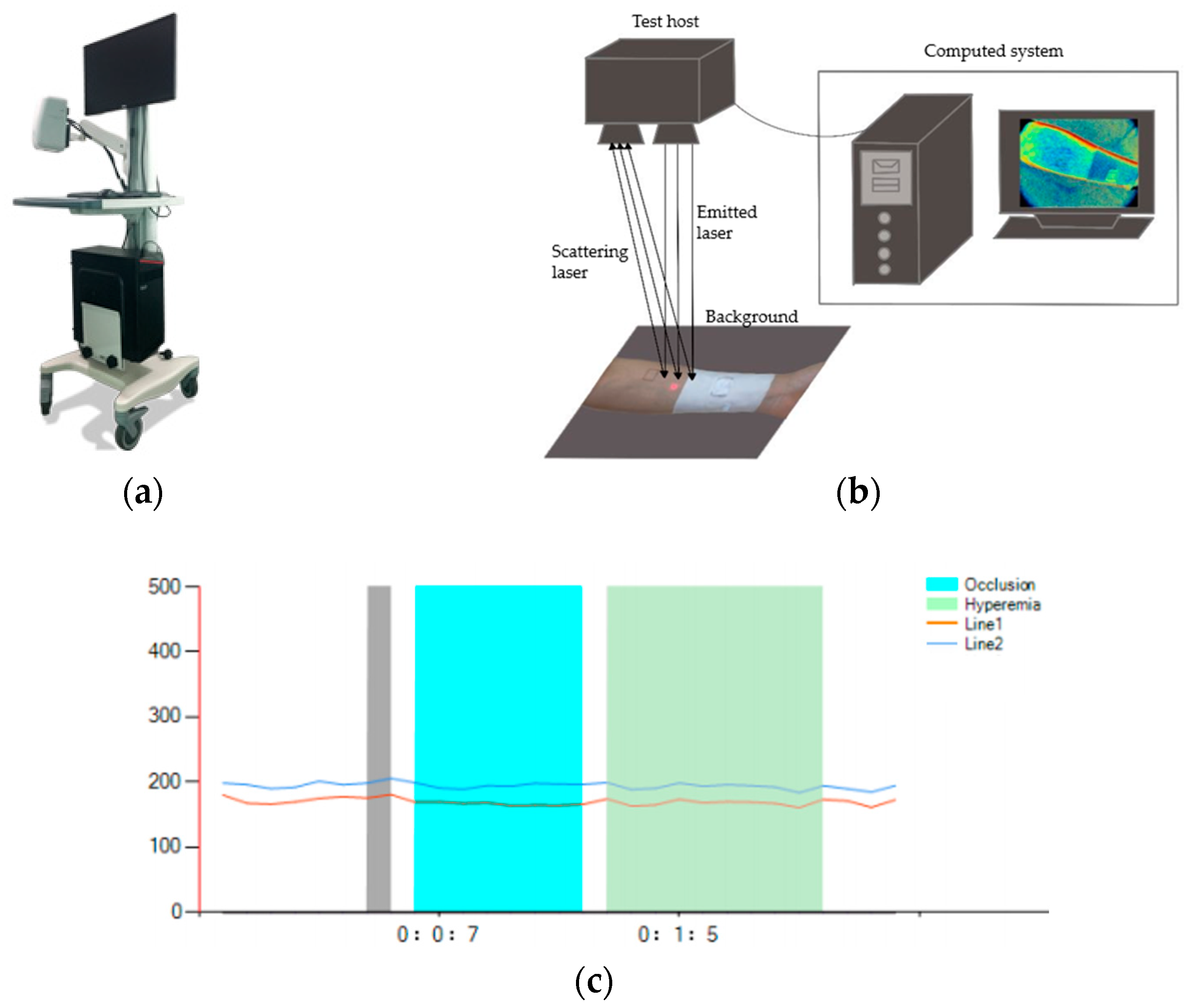

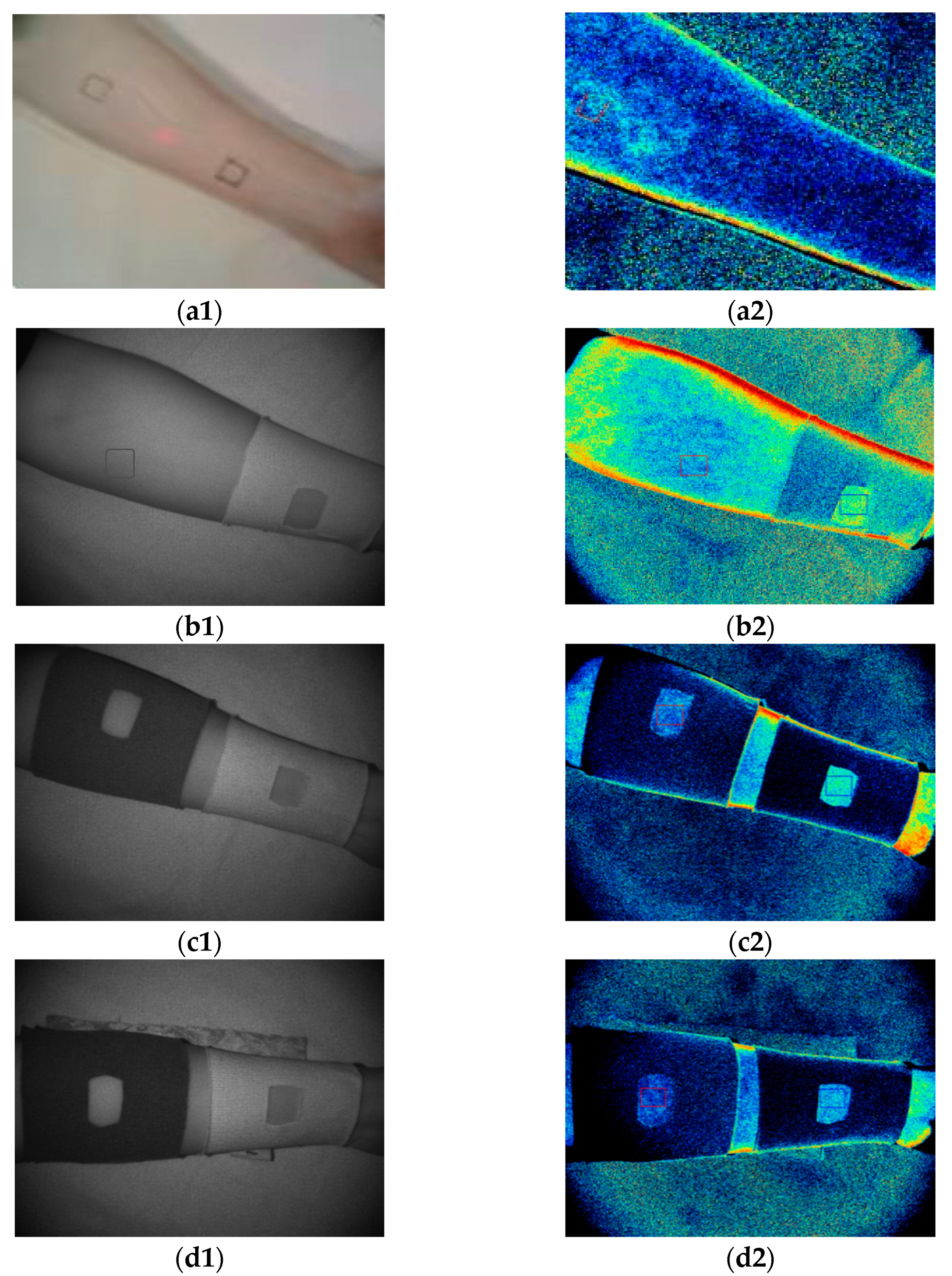
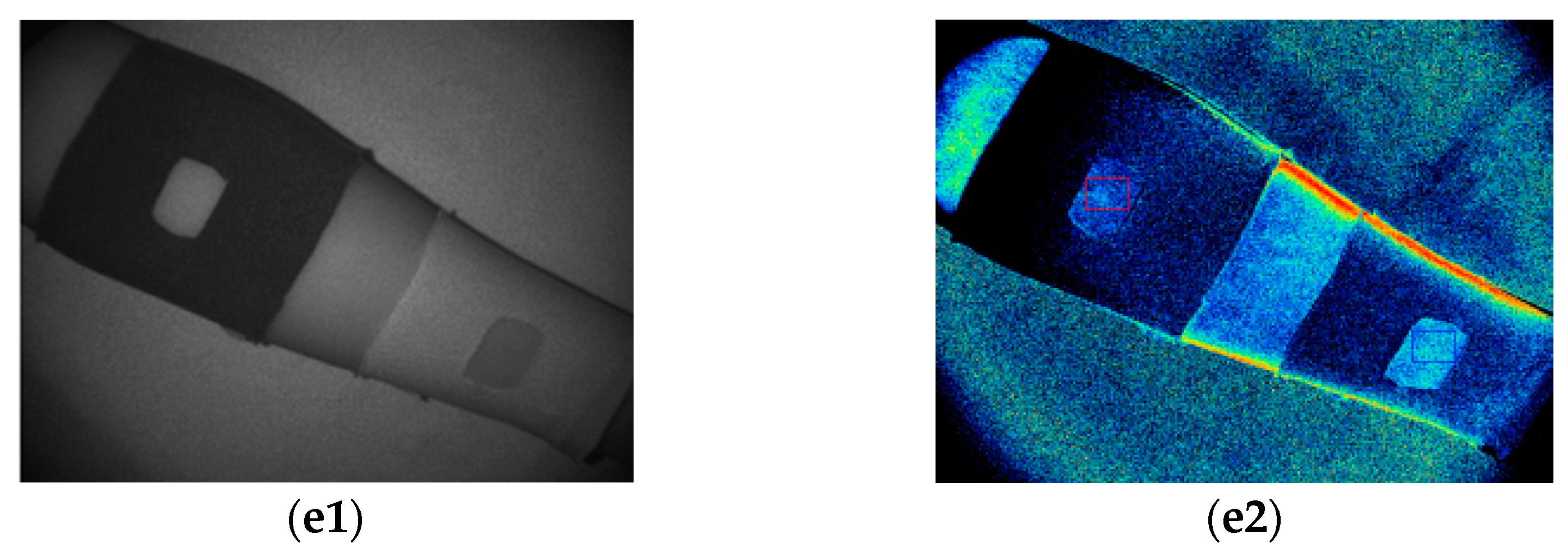
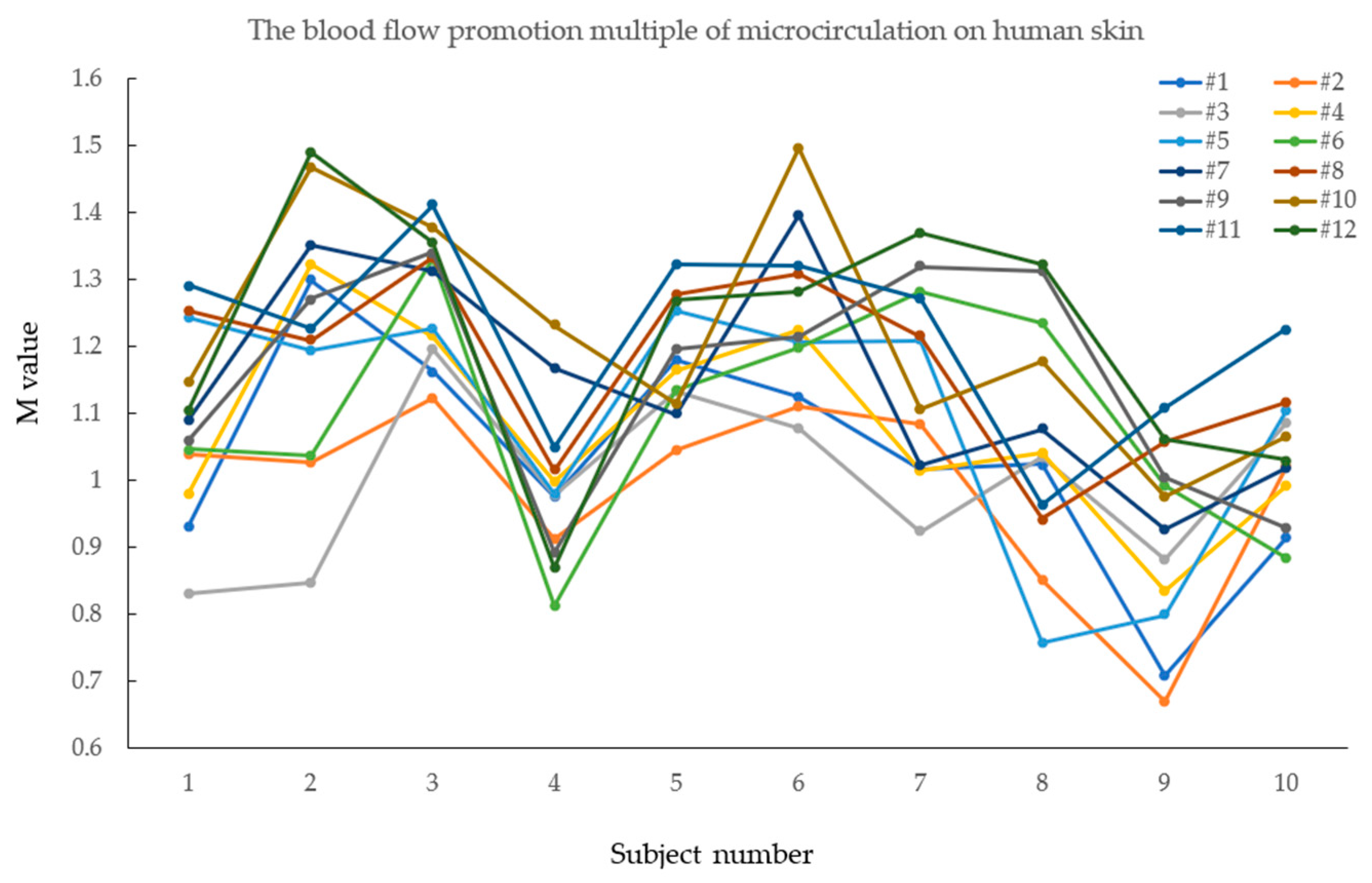
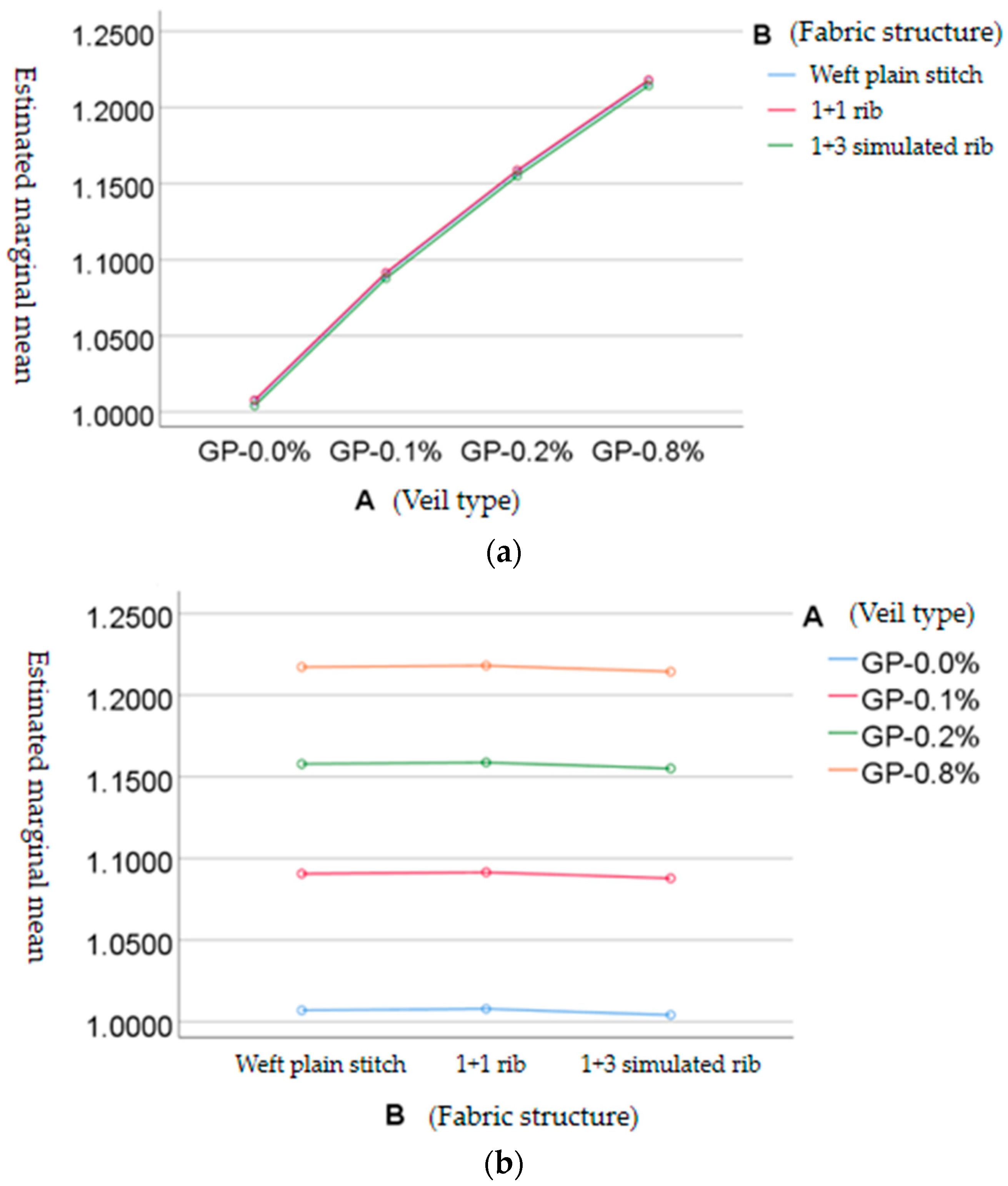
| Content | Yarn Type | Fineness | Supplier |
|---|---|---|---|
| GP-0.0% | Polyamide filament | 77.8dtex(70D) | Yiwu Huading Polyamide Co., Ltd. (Yiwu, China) |
| GP-0.1% | Graphene polyamide filament | 77.8dtex(70D) | Hangzhou Gaoxi Technology Co., Ltd. (Hangzhou, China) |
| GP-0.2% | Graphene polyamide filament | 77.8dtex(70D) | Changzhou Henglibao Nano New Material Technology Co., Ltd. (Changzhou, China) |
| GP-0.8% | Graphene polyamide filament | 77.8dtex(70D) | Shandong Shengquan New Material Co., Ltd. (Jinan, China) |
| Fabric Number | A (Veil Type) | B (Fabric Weave) |
|---|---|---|
| 1# | GP-0.0% | Weft plain stitch |
| 2# | GP-0.0% | 1+1 simulated rib |
| 3# | GP-0.0% | 1+3 simulated rib |
| 4# | GP-0.1% | Weft plain stitch |
| 5# | GP-0.1% | 1+1 simulated rib |
| 6# | GP-0.1% | 1+3 simulated rib |
| 7# | GP-0.2% | Weft plain stitch |
| 8# | GP-0.2% | 1+1 simulated rib |
| 9# | GP-0.2% | 1+3 simulated rib |
| 10# | GP-0.8% | Weft plain stitch |
| 11# | GP-0.8% | 1+1 simulated rib |
| 12# | GP-0.8% | 1+3 simulated rib |
| Average | stdDev | Points | Min | Max | Median | ||
|---|---|---|---|---|---|---|---|
| Roi1 | |||||||
| First Period | 213.56 | 0.88 | 4256 | 212.86 | 214.80 | 213.01 | |
| Second Period | 214.78 | 2.25 | 4256 | 209.33 | 218.45 | 214.88 | |
| Third Period | 215.19 | 3.95 | 4256 | 207.98 | 221.03 | 214.06 | |
| Roi2 | |||||||
| First Period | 158.59 | 1.21 | 5504 | 156.92 | 159.77 | 159.77 | |
| Second Period | 160.48 | 3.05 | 5504 | 155.94 | 167.18 | 163.61 | |
| Third Period | 160.80 | 3.03 | 5504 | 156.16 | 166.85 | 161.67 | |
| Sample Number | Tested Person | Average Value | |||||||||
|---|---|---|---|---|---|---|---|---|---|---|---|
| 1 | 2 | 3 | 4 | 5 | 6 | 7 | 8 | 9 | 10 | ||
| 1# | 0.9297 | 1.2983 | 1.1624 | 0.9755 | 1.1792 | 1.1244 | 1.0155 | 1.0236 | 0.7079 | 0.9141 | 1.0331 |
| 2# | 1.0377 | 1.0271 | 1.1224 | 0.9113 | 1.0446 | 1.1109 | 1.0841 | 0.8508 | 0.6684 | 1.0198 | 0.9877 |
| 3# | 0.8305 | 0.8471 | 1.1951 | 0.9767 | 1.1317 | 1.0772 | 0.9232 | 1.0339 | 0.8810 | 1.0851 | 0.9981 |
| 4# | 0.9789 | 1.3220 | 1.2150 | 0.9976 | 1.1631 | 1.2246 | 1.0141 | 1.0410 | 0.8345 | 0.9920 | 1.0783 |
| 5# | 1.2433 | 1.1933 | 1.2274 | 0.9803 | 1.2526 | 1.2051 | 1.2081 | 0.7565 | 0.7988 | 1.1045 | 1.0970 |
| 6# | 1.0459 | 1.0369 | 1.3295 | 0.8119 | 1.1351 | 1.1970 | 1.2809 | 1.2341 | 0.9908 | 0.8835 | 1.0946 |
| 7# | 1.0903 | 1.3509 | 1.3130 | 1.1666 | 1.0981 | 1.3953 | 1.0215 | 1.0760 | 0.9267 | 1.0177 | 1.1456 |
| 8# | 1.2529 | 1.2088 | 1.3328 | 1.0149 | 1.2768 | 1.3076 | 1.2149 | 0.9420 | 1.0573 | 1.1170 | 1.1725 |
| 9# | 1.0594 | 1.2708 | 1.3407 | 0.8921 | 1.1949 | 1.2139 | 1.3186 | 1.3117 | 1.0042 | 0.9288 | 1.1535 |
| 10# | 1.1457 | 1.4670 | 1.3779 | 1.2314 | 1.1140 | 1.4954 | 1.1059 | 1.1768 | 0.9760 | 1.0656 | 1.2156 |
| 11# | 1.2908 | 1.2271 | 1.4108 | 1.0493 | 1.3214 | 1.3199 | 1.2716 | 0.9633 | 1.1087 | 1.2258 | 1.2189 |
| 12# | 1.1042 | 1.4900 | 1.3553 | 0.8700 | 1.2687 | 1.2818 | 1.3691 | 1.3219 | 1.0602 | 1.0303 | 1.2151 |
| Dependent Variable: Promotion Multiple of Blood Flow on Human-Skin Microcirculation | ||||||
|---|---|---|---|---|---|---|
| The Source | Type III Sum of Squares | Degrees of Freedom | The Mean Square | F | Significance | Partial Eta Square |
| Modified Model | 0.074 a | 5 | 0.015 | 51.936 | 0.000 | 0.977 |
| Intercept | 14.986 | 1 | 14.986 | 52,908.098 | 0.000 | 1.000 |
| A (Type of Veil) | 0.074 | 3 | 0.025 | 86.525 | 0.000025 | 0.977 |
| B (Histological Structure) | 2.992 × 10−5 | 2 | 1.496 × 10−5 | 0.053 | 0.949 | 0.017 |
| Error | 0.002 | 6 | 0.000 | |||
| Total | 15.061 | 12 | ||||
| Total after Correction | 0.075 | 11 | ||||
| Modified Model | 0.074 a | 5 | 0.015 | 51.936 | 0.000 | 0.977 |
| Blood-Flow Promotion Multiple Human-Surface-Skin Microcirculation | |||||
|---|---|---|---|---|---|
| S-N-K a,b | |||||
| A (Veil Type) | Number of Cases | Subset | |||
| 1 | 2 | 3 | 4 | ||
| GP-0.0% | 3 | 1.006300 | |||
| GP-0.1% | 3 | 1.089967 | |||
| GP-0.2% | 3 | 1.157200 | |||
| GP-0.8% | 3 | 1.216533 | |||
| Blood-Flow Promotion Multiple Human-Surface-Skin Microcirculation | ||
|---|---|---|
| S-N-K a,b | ||
| B (Histological Structure) | Number of Cases | Subset |
| 1 | ||
| 1+3 simulated rib | 4 | 1.115325 |
| Weft plain stitch | 4 | 1.118150 |
| 1+1 simulated rib | 4 | 1.119025 |
| Significance | 0.949 | |
Publisher’s Note: MDPI stays neutral with regard to jurisdictional claims in published maps and institutional affiliations. |
© 2022 by the authors. Licensee MDPI, Basel, Switzerland. This article is an open access article distributed under the terms and conditions of the Creative Commons Attribution (CC BY) license (https://creativecommons.org/licenses/by/4.0/).
Share and Cite
Zhang, Y.; Jin, Z.; Chen, J.; Zhao, M.; Sun, Y.; Song, Y. Study and Analysis of the Effect of Polyamide Seamless Knitted Fabric with Different Graphene Content on the Blood-Flow Velocity of Human-Skin Microcirculation. Materials 2022, 15, 6853. https://doi.org/10.3390/ma15196853
Zhang Y, Jin Z, Chen J, Zhao M, Sun Y, Song Y. Study and Analysis of the Effect of Polyamide Seamless Knitted Fabric with Different Graphene Content on the Blood-Flow Velocity of Human-Skin Microcirculation. Materials. 2022; 15(19):6853. https://doi.org/10.3390/ma15196853
Chicago/Turabian StyleZhang, Yixing, Zimin Jin, Jiaxue Chen, Mingtao Zhao, Yuqiang Sun, and Yijing Song. 2022. "Study and Analysis of the Effect of Polyamide Seamless Knitted Fabric with Different Graphene Content on the Blood-Flow Velocity of Human-Skin Microcirculation" Materials 15, no. 19: 6853. https://doi.org/10.3390/ma15196853
APA StyleZhang, Y., Jin, Z., Chen, J., Zhao, M., Sun, Y., & Song, Y. (2022). Study and Analysis of the Effect of Polyamide Seamless Knitted Fabric with Different Graphene Content on the Blood-Flow Velocity of Human-Skin Microcirculation. Materials, 15(19), 6853. https://doi.org/10.3390/ma15196853






